Although some anchor roots may get to deep into the soil, most tree roots are focused in the top 12" to 18" of soil. When watering well-known trees, give a deep, saturating watering to the whole location below the tree canopy as well as prolonging numerous feet past the drip line. Ideally, you need to dampen the dirt to a deepness of 10" each time you water. To stop rot, do not apply water to the location straight around the trunk. Fully grown trees are the even more well-known trees in your yard that have actually been there for numerous years currently.
How long does it take to water 1 inch?

To determine how long you need to water to get one inch, place a plastic container in your yard and set a timer. On average, it will take 30 minutes to get a half inch of water. So, 20 minutes, three times per week will give a lawn about an inch of water. This formula works best with healthy, well-cultivated soil.
We advise spreading a 3-4" thick layer of compost around your tree within the drip line, drawing it back off the trunk a few inches. Dirt-- Clay dirts normally hold moisture, while sandy dirts dry swiftly. Recognizing your soil type can help you to adjust exactly how usually you give water for a tree. Any individual that has actually planted a tree recognizes that offering the right amount of water at the correct time is an essential factor in tree survival. Discovering just how to establish when your tree requires water as well as exactly how to apply it is an extremely fundamental part of tree possession. Take a look at our convenient guide to sprinkling trees to figure out when, where, how, as well as how much to sprinkle your tree at any type of given time. If you don't intend to water as frequently, consider applying organic compost (e.g. timber chips) around the base of your tree.
Various Other Variables Influencing A Young Trees Water Needs
Proper watering starts when you plant the tree, beginning with the tree's rootball. Be sure to completely sprinkle the whole rootball when you eliminate it from its nursery container or unwrap the cloth from around it. Usually, the soil within the rootball is completely dry and also does not conveniently absorb wetness from the bordering soil unless it's wetted before planting. Yet area of bare soil, position a 3-inch-deep layer of organic compost, such as timber chips, bent on the side of the tree or bush cover. Woody plant development and also wellness enhance when turf growing under tree and also hedge covers is removed and also replaced with organic mulch. Stay clear of light watering as this promotes shallow origin systems that are at risk to summer season heat and also drought tension. Treegator ® bags can likewise be made use of to supply a slow delivery of water over the root spheres of developing trees as well as shrubs.
What does overwatering look like?
The most obvious sign of overwatering is wilting. As stated above, leaves will turn yellow and wilted – not crisp and green. Wilting can also occur throughout the plant, including the stem, buds and flowers. You will also notice the plant growing especially slow.
Apply a 3-inch layer of organic mulch around freshly planted trees and also shrubs in a circle that prolongs numerous feet past the tree or bush cover. Youthful trees are still developing their origin systems and also therefore chlorinated water supply - gfs services ltd need more water. Water newly grew trees once a day for the first number of weeks after planting, and once a week after that during the growing season. The majority of watering systems are configured to apply frequent, superficial waterings. Trees do far better with less regular but much deeper soakings-- a heavy soaking as soon as a week is better than a superficial watering every couple of days.
Just How To Use Water
Each varieties of tree will have different watering needs, however the fundamental techniques will be basically the exact same. It is best to leave the sprinkling bag at the yard center, disentangle and/or trim the tangled origins, as well as provide your brand-new tree with opportunities to spread its roots. When a tree is transplanted, the way that it absorbs water and nutrients ought to change from how it went to the garden facility to a much more natural method. Rather applying water in the little area surrounding the trunk, the tree should have the chance to soak up water as well as nutrients from soil that is much from the trunk.
Load a huge container with water and also carry it over to the tree. You will require a minimum of 10 gallons (37.8 L) for a young tree-- a lot more for an older one. Not enough water is hazardous for the tree, however excessive water misbehaves also. Please note that moist is different than soaked, as well as you can judge this by feel. A wet dirt that dries out for a brief period will certainly enable adequate oxygen to permeate the dirt. For new trees, water immediately after you plant a tree.
GFS Services Ltd
40168 Talbot Line St ThomasON N5P 3T2 Canada
519-633-1391